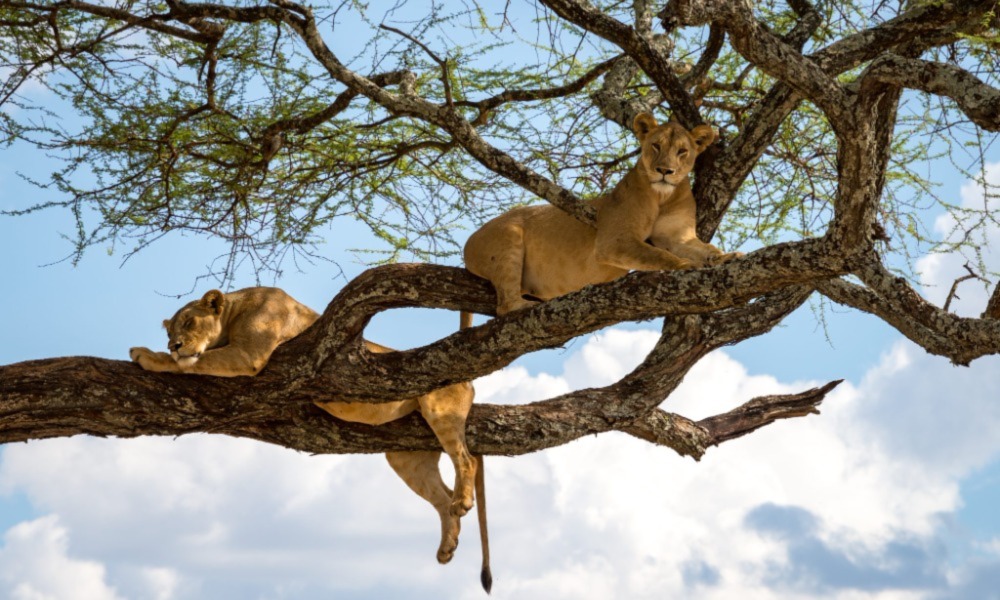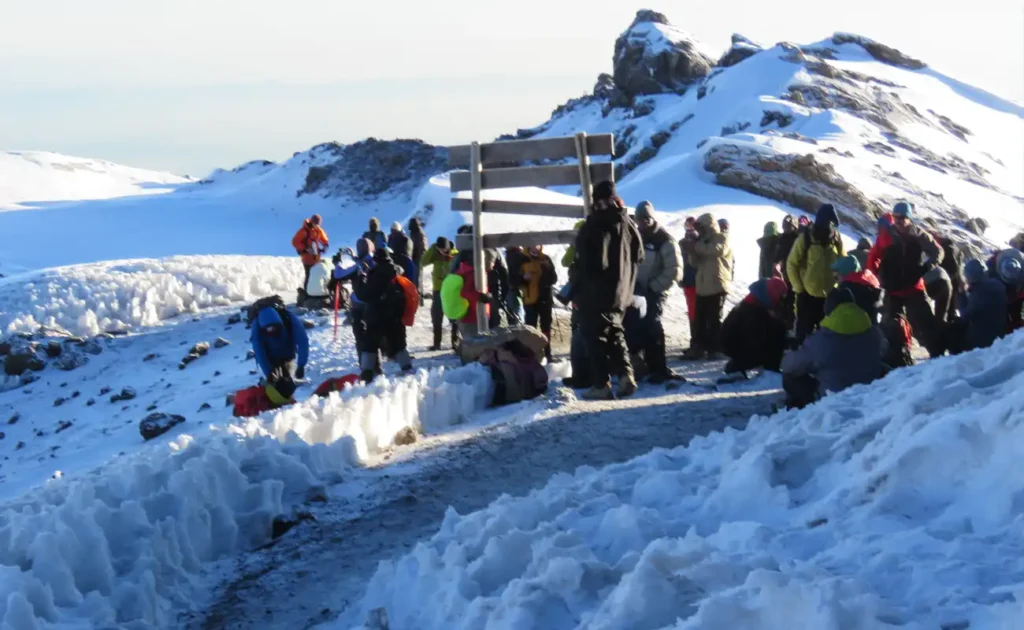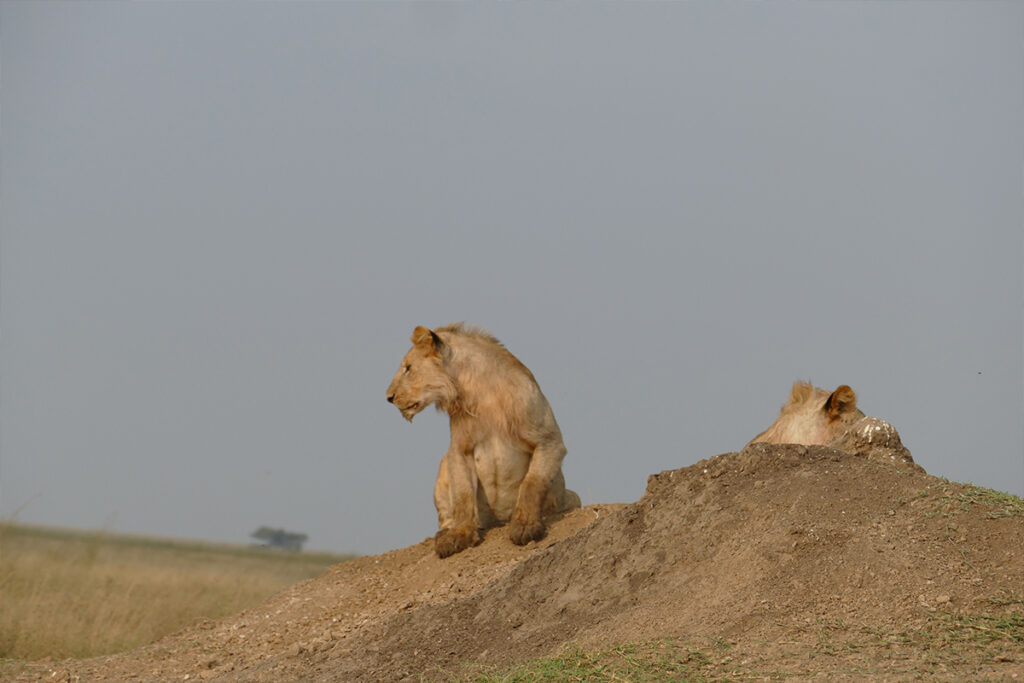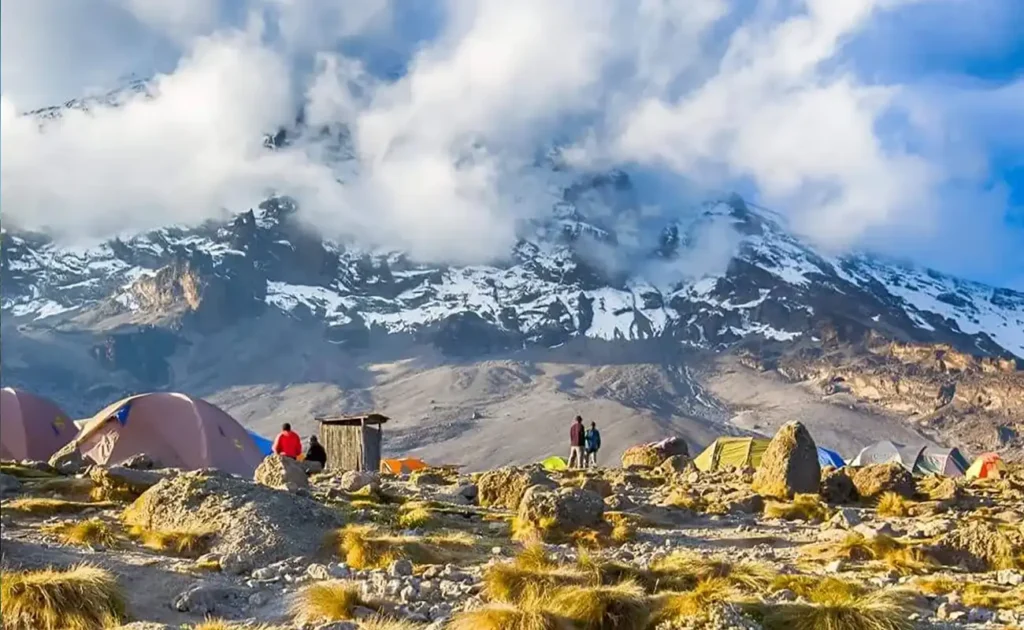The unexpected sight of lions leisurely lounging in trees has astounded many seasoned wildlife enthusiasts at Lake Manyara. This behavior is not merely a spectacle but a fascinating adaptation, possibly to escape from ground heat and insects. Coupled with the striking beauty of flamingos dazzling the lake with their pink elegance, this safari offers a visual feast like no other.
Lake Manyara, nestled in the Great Rift Valley, is a historical gem within Tanzania’s national parks. Known for its unique tree-climbing lions, the park covers over 330 square kilometers, 70% of which is flooded by the lake itself. The park also supports a seasonal congregation of flamingos, culminating in breathtaking vistas that have secured its status among the finest safari destinations.

Lake Manyara Safari: An Overview
Lake Manyara, part of Tanzania, is a treasure trove for wildlife enthusiasts. Nestled in the Great Rift Valley, it offers stunning landscapes. The area hosts several ecosystems, from groundwater forests to woodlands. With its diverse habitats, it supports an incredible range of animals. Adventurers visiting the park can catch glimpses of zebras, giraffes, and more.
One standout feature of Lake Manyara is its tree-climbing lions. Unlike most lions that stay on the ground, these have adapted to rest in trees. Observers believe they climb to avoid heat and pesky insects on the ground. This atypical behavior draws many tourists every year. Spotting these lions is a unique safari experience.
Birdwatchers flock to Lake Manyara National Park, captivated by its avian residents. Flamingos create stunning visuals as they congregate in large numbers. Their pink hues contrast beautifully with the blue waters. The park plays host to over 400 bird species. This makes it a paradise for those keen on bird photography.
There are several things to keep in mind when visiting Lake Manyara. One is the best time to go, varying depending on what you want to see. Dry seasons are ideal for wildlife viewing. Meanwhile, bird enthusiasts may want to visit during the wet season. Remembering these can enhance your safari adventure.
Geography and Climate of Lake Manyara
Lake Manyara sits within Tanzania, nestled against the Great Rift Valley. Spanning around 330 square kilometers, it offers varied landscapes. The park’s terrain shifts from lush forests to sprawling grasslands. This unique geography creates diverse habitats for wildlife. Additionally, the dramatic escarpment further enhances its breathtaking scenery.
The lake itself covers a significant portion of the park. Its alkaline waters are fed by multiple streams and underground springs. This environment is perfect for flamingos and other bird species. The richness of the lake sustains numerous aquatic creatures. Consequently, it plays a vital role in the park’s ecosystem.
Climatic conditions in the region are equally diverse. Most rainfall occurs during the wet season from November to May. This time revitalizes the park’s vegetation. A dry spell takes over from June to October, making wildlife viewing easier. Such variation ensures the park remains a year-round attraction.
Understanding the geography and climate can enhance a visitor’s experience. Staying aware of weather patterns helps in trip planning. Different seasons offer diverse attractions and activities. Depending on interests, visitors can choose the best time to visit. Preparing accordingly can make a safari truly memorable.
Flora and Fauna Highlights
Lake Manyara is a haven for both plants and animals. The park boasts a rich tapestry of ecosystems, each supporting different species. Thick forests line the groundwater areas, hosting large fig and mahogany trees. These trees provide shelter and food for various animals. The diversity of flora forms the backbone of the park’s vibrant wildlife.
In terms of fauna, the park is home to a wide range of animals. From the famous tree-climbing lions to herds of elephants, the variety is impressive. Herds of zebras and wildebeests roam the open grasslands. Monkeys and baboons are common sights, often seen playing near the trees. Each animal plays a unique role in the park’s ecosystem.
Bird lovers are in for a treat at Lake Manyara. With over 400 species, the park is a birdwatcher’s paradise. Flamingos paint the lake pink during certain seasons. Other common birds include pelicans, hornbills, and storks. Bird enthusiasts often consider this park a must-visit destination.
The variety of flora and fauna in Lake Manyara supports a dynamic ecosystem. Visitors can appreciate how each element contributes to the whole. Observing these interactions enriches the safari experience. Guides often provide insights into the unique behaviors of both plants and animals. Learning about such interdependencies makes every visit educational and fascinating.
Conservation Efforts in the Park
Lake Manyara National Park is dedicated to protecting its rich biodiversity. Park rangers play a vital role in guarding the area against poaching and illegal activities. They regularly patrol to ensure the safety of both animals and habitats. Partnering with local communities enhances these efforts. Together, they strive to maintain the park’s ecological balance.
Various organizations collaborate on projects to sustain Lake Manyara’s ecosystem. These projects are designed to tackle issues like habitat degradation. By planting native trees, they restore vital habitats for the wildlife. Educational programs for locals aim to raise awareness about conservation benefits. Community involvement strengthens the park’s protection measures.
One key focus is the preservation of endangered species. Efforts are underway to monitor populations and provide essential care. Lion populations, known for their unique tree-climbing behavior, receive special attention. Collaboration with experts helps develop effective strategies. These initiatives are crucial for the survival of rare species.
Water conservation is also prioritized due to the park’s reliance on Lake Manyara. Protecting water sources ensures the lake remains a haven for birds like flamingos. This involves monitoring water quality and managing pollution risks. Sustainable water use practices are encouraged to support the ecosystem. Ensuring clean water is fundamental to the park’s health.
Conservation efforts extend to enhancing visitor experiences sustainably. Ecotourism initiatives encourage visitors to respect the natural environment. Trails and facilities are designed to minimize impact. Tourists are educated on responsible behaviors within the park. This approach helps preserve Lake Manyara for future generations.
Visitor Experiences and Activities
Visitors to Lake Manyara National Park are in for a memorable adventure. The park offers a range of activities to suit different interests. One popular choice is a guided safari drive, where guests can observe wildlife in their natural habitats. Skilled guides share insights about the animals and plants along the way. These drives provide a unique chance to see elephants, giraffes, and lions up close.
Birdwatching enthusiasts will find Lake Manyara to be a paradise. The lake is home to hundreds of bird species, making it perfect for spotting unique avian life. Flamingos and pelicans are among the favorites. Visitors might even spot the colorful little bee-eaters. With a pair of binoculars and a bit of patience, the sights are truly rewarding.
For those who prefer exploring on foot, walking safaris offer a different perspective. Accompanied by experienced guides, visitors can learn about the smaller creatures and plants often missed from vehicles. It’s an opportunity to connect closely with nature and appreciate its wonders. Walking safaris allow guests to feel the thrill of a more intimate bush experience. Safety is prioritized, ensuring a secure yet thrilling adventure.
The park also caters to families with its picnic spots. These areas provide a space to relax amidst nature. Families can enjoy a meal while soaking in the beautiful surroundings. It’s an ideal way to take a break and appreciate the serene environment. Kids often delight in simple pleasures like watching monkeys play nearby.
Photography enthusiasts can capture the stunning landscapes and wildlife throughout the park. Sunrise and sunset hours cast magical lights, perfect for photos. Visitors are encouraged to share their experiences and support conservation efforts. Showing these incredible vistas inspires awareness and respect for nature. Remember to follow guidelines to preserve the park’s beauty for future visitors.
Unique Behaviors of Tree-Climbing Lions
Tree-climbing lions in Lake Manyara are a fascinating sight. Unlike most lions that prefer staying on the ground, these lions have adapted to life above. Resting on branches allows them to escape the heat and avoid annoying insects. Watching these majestic animals perched high up is unforgettable. Their presence in trees adds a unique touch to the safari experience.
There are several theories about why these lions climb trees. Some believe it’s a learned behavior passed down from older lions. It’s possible they climb to gain a better view of their surroundings. Others think it helps them avoid water-soaked ground during heavy rains. Regardless of the reason, it sets them apart from typical lion behavior.
Visitors to the park have numerous opportunities to witness these lions. Early morning and late afternoon are ideal times to spot them in trees. During these hours, the temperature is cooler, and lions are more active. Rangers and guides assist tourists in locating these elusive climbers. It’s a thrilling moment when you finally see them resting atop a branch.
Observing tree-climbing lions provides valuable insights into their habits and adaptations. Researchers and wildlife enthusiasts are keen on studying this rare behavior. By understanding their actions, we learn more about lion survival strategies. Insights gained could help in conservation efforts to protect these amazing animals. Ensuring their safety means future generations can marvel at their unique skills.
The phenomenon of tree-climbing lions isn’t just limited to Lake Manyara. Certain groups in other parts of Africa, like Queen Elizabeth National Park in Uganda, exhibit this behavior as well. It suggests that similar environments influence this trait. When regions present comparable conditions, lions seem to adapt similarly. This cross-continental behavior hints at wider environmental impacts on wildlife habits.
Seasonal Patterns of Flamingos at Lake Manyara
Flamingos are a striking feature at Lake Manyara, known for their seasonal migrations. During certain times of the year, the lake becomes a sea of pink. Large flocks arrive to feed on the rich algae and crustaceans. These gatherings create one of the most breathtaking natural spectacles in Tanzania. The timing and numbers can vary with changing conditions.
The presence of flamingos often peaks during the wet season, from November to May. As rains fill the lake, food sources increase dramatically. This attracts flamingos in search of nutrient-rich habitats. It’s not uncommon to see thousands gathered together. Such density offers an awe-inspiring view and excellent photo opportunities.
Drier periods from June to October see a reduction in their numbers. However, some flamingos remain by relocating to other parts of the lake or nearby waters. Environmental changes impact their movements throughout the area. Understanding these patterns helps predict when viewing will be at its best. Trip planning can then be tailored accordingly.
Besides flamingos, other bird species flock to Lake Manyara influenced by similar seasonal patterns. The interplay between various species enriches the avian biodiversity here. This makes every visit unique as different birds dominate at varying times. Birdwatchers keep returning to witness these fascinating transitions.
The phenomenon isn’t just about visual delight; it speaks volumes about ecological health too.
Lake Manyara’s changing conditions reflect wider environmental shifts affecting wildlife migratory behaviors globally.
Observing such trends provides valuable insights into ecosystem dynamics.
Ensuring clean water is fundamental for sustaining both flora and fauna.
Maintaining this balance ensures that future generations can continue enjoying these wonders.
Planning Your Visit to Lake Manyara
When planning a visit to Lake Manyara, timing is crucial for maximizing your experience. Depending on the season, you might witness different wildlife activities. The dry season, from June to October, is perfect for spotting large mammals such as elephants and tree-climbing lions. Water sources shrink, making it easier to find animals gathered at the remaining water holes. During this time, vegetation is less dense, improving visibility.
The wet season from November to May offers a different spectacle. The park becomes lush with greenery, offering a vibrant backdrop for birdwatching. Thousands of birds, including flamingos, flock to the lake, drawn by the abundant food. This period may have fewer big game sights, but the bird activity and blooming landscapes are breathtaking. Visitors won’t want to miss this colorful transformation of the park.
Deciding where to stay in or near Lake Manyara is an essential part of planning. Accommodation options range from luxury lodges to budget-friendly campsites. Each provides diverse experiences, depending on your preferences. Some lodges offer guided tours and other services that could enhance your stay. Comparing options can help you find the perfect base for your adventure.
Packing smartly enhances the enjoyment of your safari adventure. Lightweight clothing, binoculars, and a good camera are must-haves. Don’t forget sunscreen and insect repellent to stay comfortable during excursions. Guides often provide useful tips on what to bring based on your planned activities. Careful preparation ensures a smooth and enjoyable trip.
Regulations and entry requirements at Lake Manyara are observed to maintain its pristine environment. Visitors are urged to follow guidelines for conservation. Simple actions like sticking to marked trails and not feeding animals help protect the park. Being respectful of local customs benefits both the park and its guests. Adhering to these ensures that the beauty of Lake Manyara remains preserved.
Photography Tips for Capturing Wildlife at Lake Manyara
Capturing the beauty of wildlife at Lake Manyara requires some preparation and patience. Sunrise and sunset provide the best natural lighting for photos. These “golden hours” cast a warm, soft light that enhances the colors of wildlife. Be ready with your camera during these times. The long shadows and softer light can make for stunning photographs.
Using the right camera settings will improve your chances of getting great shots. A fast shutter speed is essential for capturing moving animals. Adjusting the ISO settings can help in low-light conditions. Practice using different modes and settings to become more familiar with your camera. This practice can make a big difference during your safari.
Being patient and observing animal behavior can lead to amazing photos. Spend time watching how animals interact with each other and their environment. This can help you anticipate interesting actions or moments. Sometimes the most extraordinary shots come from waiting and watching quietly. Remember, patience often rewards the persistent photographer.
Composing your photos thoughtfully is another key tip. Consider the rule of thirds, where you divide the frame into nine equal sections. Place your subject along these lines or at their intersections to create balanced and engaging photos. Experiment with different angles and perspectives. Moving around your subject can give a fresh and dynamic view.
Respecting the wildlife is crucial while taking photos. Always maintain a safe distance from the animals to avoid disturbing them. Use a telephoto lens to get close-up shots without compromising safety. Following these guidelines ensures both your safety and the well-being of the animals. A responsible approach makes for a more enjoyable and ethical photography experience.
Key Takeaways
- Lake Manyara Safari features tree-climbing lions and pink flamingos.
- The park is in Tanzania’s Great Rift Valley.
- The best time for birdwatching is during the wet season.
- Dry season offers prime big game viewing opportunities.
- Guides enhance the experience with expert knowledge.



